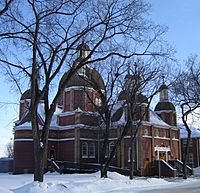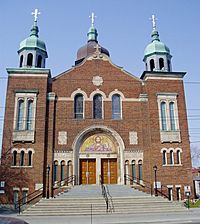Ukrainian Canadians facts for kids
| Українські канадці | |
|---|---|
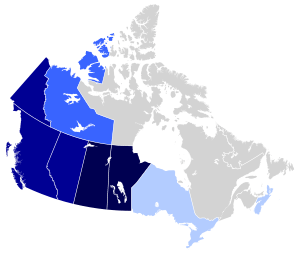
Ukrainian Canadians as percent of population by province & territory
|
|
| Total population | |
| 1,359,655 (by ancestry, 2016 Census) | |
| Regions with significant populations | |
| West | 922,050 (8.3%) |
| Central | 418,990 (1.9%) |
| Atlantic | 14,930 (0.6%) |
| North | 3,685 (3.2%)
|
| 376,440 (2.8%) | |
| 369,090 (9.3%) | |
| 229,205 (5.0%) | |
| 180,055 (14.5%) | |
| 143,700 (13.4%) | |
| Languages | |
| Canadian English, Canadian Ukrainian (also Quebec French, Ukrainian, Russian) |
|
| Religion | |
| Ukrainian Orthodox, Ukrainian Catholic, Roman Catholic, others | |
| Related ethnic groups | |
| Polish Canadians, Ukrainian Americans, Ukrainians, Slavs | |
Ukrainian Canadians are Canadian citizens who have Ukrainian family roots or were born in Ukraine and moved to Canada.
The first Ukrainian immigrants came to Canada in the late 1800s. They were mostly farmers and workers seeking a better life and more opportunities. Many settled in western Canada, especially in Manitoba, Saskatchewan, and Alberta. These areas had good land for farming, which was familiar to most Ukrainians. They built strong communities, including churches, community centers, and cultural groups, to keep their language and traditions alive. After 1920, many moved to cities in Ontario.
In the early years, Ukrainian immigrants faced unfair treatment and prejudice. This was partly because they were seen as "foreign." A difficult time was during World War I, when some Ukrainian Canadians were held in camps. This happened because they came from Austria-Hungary, a country Canada was fighting. Even though few supported Austria-Hungary, thousands were held between 1914 and 1920. This event had a lasting impact and is now recognized as a historical injustice.
Today, Ukrainian Canadians are a vital part of Canada's diverse culture. They have helped Canada grow and continue to celebrate their rich heritage. In 2016, about 1.3 million people in Canada had full or partial Ukrainian roots. This makes them Canada's eleventh largest ethnic group. Canada has the third-largest Ukrainian population in the world, after Ukraine and Russia. Many Ukrainians live in rural areas of Western Canada. In 2011, about 11.5% of Ukrainian Canadians could speak the Ukrainian language.
Contents
History of Ukrainian Canadians
| Ukrainian Canadian Population History |
||
|---|---|---|
| Year | Pop. | ±% |
| 1901 | 5,682 | — |
| 1911 | 75,432 | +1227.6% |
| 1921 | 106,721 | +41.5% |
| 1931 | 225,113 | +110.9% |
| 1941 | 305,929 | +35.9% |
| 1951 | 395,043 | +29.1% |
| 1961 | 473,337 | +19.8% |
| 1971 | 580,660 | +22.7% |
| 1981 | 529,615 | −8.8% |
| 1986 | 961,310 | +81.5% |
| 1991 | 1,054,295 | +9.7% |
| 1996 | 1,026,475 | −2.6% |
| 2001 | 1,071,060 | +4.3% |
| 2006 | 1,209,090 | +12.9% |
| 2011 | 1,251,170 | +3.5% |
| 2016 | 1,359,655 | +8.7% |
| Source: Statistics Canada Note1: 1981 Canadian census did not include multiple ethnic origin responses, thus population is an undercount. Note2: 1996-present census populations are undercounts, due to the creation of the "Canadian" ethnic origin category. |
||
Early Settlements Before 1891
Some historians believe a few Ukrainians might have settled in Canada before 1891. For example, some think Ukrainians were soldiers with Polish people in a Swiss-French regiment during the War of 1812. These soldiers might have stayed in Upper Canada (now southern Ontario). Other Ukrainians may have arrived with different immigrant groups. Some individual Ukrainian families might have settled in southern Manitoba in the 1870s. They came alongside Mennonites and Germans from the Russian Empire. "Galicians" were also noted among miners during the British Columbia gold rushes in 1871. However, there is not much clear proof for these early arrivals. So, they are not usually counted as the first Ukrainians in Canada.
First Wave of Settlers: 1891–1914
During the 1800s, the land where Ukrainians lived in Europe was split between the Austro-Hungarian and Russian empires. Many Ukrainian speakers lived in the Austrian areas of Galicia and Bukovina. Austrian Galicia was very poor and had too many people. There were also many famines. People were already moving from Galicia to other places like the Balkans and Brazil before 1891.
The first big wave of Ukrainian immigration to Canada started with Iwan Pylypow and Wasyl Eleniak. They arrived in 1891 and brought more families in 1892. Pylypow helped start the Edna-Star Settlement near Edmonton. This was the first and largest Ukrainian "block settlement," where many people from the same background settled together. Dr. Josef Oleskow and Cyril Genik are known for encouraging many Ukrainians from western Ukraine to come to Canada in the late 1890s. About 170,000 Ukrainians from the Austro-Hungarian Empire arrived in Canada between 1891 and 1914.
Clifford Sifton, Canada's Minister of the Interior from 1896 to 1905, also encouraged Ukrainians from Austria-Hungary to come. He wanted new farmers to settle Canada's prairies. Sifton believed these hardworking farmers would be good for Canada.
Most of these Ukrainian immigrants were farmers. They settled in specific areas called block settlements in the prairie provinces: Alberta, Saskatchewan, and Manitoba. They often chose wooded areas, even if the land was not as good for crops. This was because they needed wood for building and heating, which they had to pay for in their home country. They also wanted to settle near family and people from their home villages. This helped the block settlements grow.
These settlers formed groups to help each other. Some examples include the Ukrainian Labour Farmer Temple Association (ULFTA) and the Ukrainian Catholic Brotherhood (UCB). By 1914, Ukrainian communities also grew in eastern Canadian cities like Toronto and Montreal. Many of these immigrants came from Russian-ruled Ukraine. In these early years, Ukrainian immigrants faced a lot of discrimination. One example was the internment during World War I.
Internment (1914–1920)
During World War I, from 1914 to 1920, the Canadian government called immigrants from Austria-Hungary "enemy aliens." This was allowed by the War Measures Act of 1914. It meant the government could force thousands of Ukrainians in Canada to register with authorities. About 5,000 Ukrainian men, and some women and children, were held in government camps and work sites.
Many Ukrainians were released to work for private companies by 1917. However, the internment continued until June 20, 1920. This was almost a year after the war officially ended.
There are many plaques and memorials across Canada that remember these internment operations. Some statues have been put up, for example, in Banff National Park and Kapuskasing. On August 24, 2005, Prime Minister Paul Martin called the Ukrainian Canadian internment a "dark chapter" in Canadian history.
On May 9, 2008, the Canadian government created a $10 million fund. This fund helps pay for projects that remember the experiences of Ukrainians and other Europeans held in camps between 1914 and 1920. One project in 2014 placed 115 bilingual plaques across Canada. This marked 100 years since the War Measures Act was first used.
Second Wave: 1923–1939
In 1923, the Canadian government changed its Immigration Act. This allowed people from the former Austrian Empire to enter Canada again. So, Ukrainian immigration started up once more. About 70,000 Ukrainians from Poland, Romania, and Czechoslovakia came to Canada from 1923 to 1939. However, fewer arrived after 1930 because of the Great Depression.
By this time, there was not much farmland left. So, less than half of these new immigrants settled as farmers. Most became workers in growing industrial areas. They found jobs in southern Ontario, Montreal, and Quebec. They also worked in mines, smelters, and forests in northern Ontario. A few Ukrainian professionals and thinkers were also allowed into Canada. They later became leaders in the Ukrainian Canadian community.
This second wave of immigrants was strongly influenced by Ukraine's fight for independence. They formed two main groups in Canada: the United Hetman Organization (UHO) and the Ukrainian National Federation (UNF). The UNF became the largest and most important Ukrainian group in Canada. It helped create the Ukrainian Canadian Committee (now Ukrainian Canadian Congress) during World War II.
Third Wave: 1945–1980s
From 1945 to 1952, most Ukrainians coming to Canada were refugees after World War II. Many had been forced to leave their homes and were looking for a safe place. In the 1950s and 1960s, many Ukrainians living in refugee camps in Europe got the chance to move to Canada. These immigrants were often skilled and educated. They helped Canada's economy grow.
Another group of Ukrainian immigrants arrived in the 1970s and 1980s. They were leaving Ukraine due to political and economic reasons. Many were unhappy with the Soviet government. They wanted more freedom and opportunities. Economic problems like job shortages also made them want to leave.
During this time, many Ukrainian immigrants settled in cities like Toronto and Montreal. They found work in factories and other industries. Even though they faced some challenges, Ukrainian immigrants built strong communities in Canada. They also worked to keep their culture and heritage alive. Large Ukrainian communities grew in Toronto, Montreal, and Vancouver. They started new organizations and groups, like the Canadian League for the Liberation of Ukraine.
Fourth Wave: 1991–Present
After the Soviet Union broke apart in 1991, more people started leaving Ukraine. Problems like corruption, fewer social services, low-paying jobs, and job losses made moving away appealing. Many Ukrainians saw Canada as a place with opportunities to build a better life. The Canadian government also made it easier for Ukrainians to immigrate. They offered programs to attract skilled workers and business owners.
One popular program was the Federal Skilled Worker Program. It allowed skilled workers to immigrate based on their education, work experience, and language skills. Many Ukrainians also came to Canada through family sponsorship. This meant they had family members already living in Canada who could help them immigrate. Besides economic chances, Ukrainians liked Canada's diverse society and the freedoms it offered. Many Ukrainian immigrants have made important contributions to Canada in business, education, politics, and the arts.
Ukrainian Canadians in the Economy
In the first half of the 1900s, most Ukrainian Canadians worked in basic industries. They were mainly farmers. They also worked in mining, logging, and building. Many helped extend Canada's railway system. They were important laborers in finishing the transcontinental mainlines.
As farming became more modern, Ukrainian men moved to other jobs. They worked in non-farm industries and factories. Women often took jobs as domestic workers or in basic service industries. By 1971, about the same number of Ukrainian Canadians worked in farming as other Canadians. Today, Ukrainian Canadians are still a bit more likely to work in agriculture. However, they have mostly joined the wider Canadian economy. Their jobs are now similar to those of other Canadians in most ways.
Demographics of Ukrainian Canadians
Note1: 1981 Canadian census did not include multiple ethnic origin responses, thus population is an undercount.
Note2: 1996-present census populations are undercounts, due to the creation of the "Canadian" ethnic origin category.
Note1: 1981 Canadian census did not include multiple ethnic origin responses, thus population is an undercount.
Note2: 1996-present census populations are undercounts, due to the creation of the "Canadian" ethnic origin category.
Ukrainian Canadian Population History
| Year | Population | % of total population |
|---|---|---|
| 1901 |
5,682 | 0.106% |
| 1911 |
75,432 | 1.047% |
| 1921 |
106,721 | 1.214% |
| 1931 |
225,113 | 2.169% |
| 1941 |
305,929 | 2.659% |
| 1951 |
395,043 | 2.82% |
| 1961 |
473,337 | 2.595% |
| 1971 |
580,660 | 2.692% |
| 1981 |
529,615 | 2.199% |
| 1986 |
961,310 | 3.842% |
| 1991 |
1,054,295 | 3.906% |
| 1996 |
1,026,475 | 3.598% |
| 2001 |
1,071,060 | 3.614% |
| 2006 |
1,209,090 | 3.87% |
| 2011 |
1,251,170 | 3.808% |
| 2016 |
1,359,655 | 3.946% |
Language and Communication

Besides Canada's official languages, English and French, many public schools in the prairies offer Ukrainian language classes. Some even have immersion programs. Students usually learn the local Canadian Ukrainian dialect, not the standard Ukrainian spoken in Ukraine.
The Canadian Ukrainian dialect developed from the Ukrainian spoken by the first immigrants from 1891 to 1914. Back then, the Ukrainian language did not have words for many modern things like cars or power tools. So, Ukrainian settlers in Canada borrowed words from English or made up new ones. They were also cut off from Ukraine for a long time, especially between 1939 and 1989. This made the Canadian Ukrainian dialect different from the Ukrainian spoken in Ukraine today. New immigrants from Ukraine sometimes find the Canadian dialect old-fashioned or strange.
There are also Ukrainian Catholic elementary schools in the Greater Toronto Area. These include St. Demetrius, St. Josaphat, and Josef Cardinal Slipyj Elementary schools in Etobicoke. St. Sofia Catholic Elementary school is in Mississauga.
Religious Practices
Most Ukrainians who came to Canada from Galicia were Ukrainian Catholic. Those from Bukovina were Ukrainian Orthodox. Both groups faced a shortage of priests in Canada. Ukrainian Catholic priests had disagreements with the Roman Catholic leaders. This was because Ukrainian Catholic priests could marry, and they wanted their own separate church structure.
At that time, the Russian Orthodox Church was the only Orthodox Christian church in North America. This was because they arrived first in Alaska. However, Ukrainians in Canada did not want to be controlled by Russia. So, the Ukrainian Orthodox Church of Canada was created. This church was fully controlled by Ukrainian Canadians. Also, the Ukrainian Catholic clergy eventually got their own separate structure from the Roman Catholic Church.
Where Ukrainian Canadians Live
- Information in this section taken from Statistics Canada, 2016.
Provinces and Territories
| Province / Territory | Percent Ukrainian | Total Ukrainians |
|---|---|---|
| 9.3% | 369,090 | |
| 5.0% | 229,205 | |
| 14.5% | 180,055 | |
| 0.5% | 3,535 | |
| 0.3% | 1,350 | |
| 3.2% | 1,290 | |
| 1.0% | 9,115 | |
| 0.5% | 190 | |
| 2.8% | 376,440 | |
| 0.7% | 930 | |
| 0.5% | 42,550 | |
| 13.4% | 143,700 | |
| 6.3% | 2,205 | |
| Total | 3.9% | 1,359,655 |
The provinces with the most Ukrainians (counting both full and partial Ukrainian heritage in 2006) are Ontario (336,355), Alberta (332,180), British Columbia (197,265), Manitoba (167,175), Saskatchewan (129,265), and Quebec (31,955).
In terms of what percentage of the total population is Ukrainian, the top provinces and territories are Manitoba (15%), Saskatchewan (13%), Alberta (10%), Yukon (5%), British Columbia (5%), and Ontario (3%).
Cities with Ukrainian Populations
| City | Population | Ukrainian Population | Percentage of Ukrainians (out of total population) |
Percentage of all Canadian Ukrainians |
|---|---|---|---|---|
| Calgary | 1,239,220 | 77,670 | 6.4% | 5.7% |
| Edmonton | 932,546 | 98,820 | 10.8% | 7.3% |
| Hamilton | 536,917 | 18,990 | 3.6% | 1.4% |
| Montreal | 1,704,694 | 18,010 | 1.1% | 1.3% |
| Ottawa | 923,243 | 24,965 | 2.7% | 1.8% |
| Regina | 215,106 | 26,590 | 12.6% | 2.0% |
| Saskatoon | 246,376 | 38,600 | 16.0% | 2.8% |
| Toronto | 2,721,571 | 72,345 | 2.7% | 5.3% |
| Vancouver (Metro Vancouver) | 2,463,431 | 94,400 | 3.9% | 6.9% |
| Victoria | 85,792 | 5,015 | 6.1% | 0.4% |
| Windsor | 217,188 | 6,165 | 2.9% | 0.5% |
| Winnipeg | 705,244 | 99,365 | 14.4% | 7.3% |
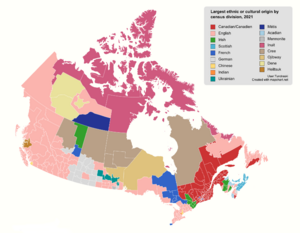
- Information in this section taken from both 2006 Census Community Profiles, and Statistics Canada, 2016.
The cities with the largest Ukrainian populations (single and multiple origins, 2006) are Edmonton (144,620), Toronto (122,510), Winnipeg (110,335), Vancouver (81,725), Calgary (76,240), and Saskatoon (38,825).
Some smaller rural communities in Western Canada also have many Ukrainians (single and multiple origins, 2016). These include Canora, Saskatchewan (52.6%), Speers, Saskatchewan (50%), Andrew, Alberta (48%), Mundare, Alberta (46%), Bradwell, Saskatchewan (41%), Vilna, Alberta (40%), Smoky Lake, Alberta (39%), and Hafford, Saskatchewan (39%).
Ukrainian Canadian Culture
Ukrainian Canadians have created their own unique culture in Canada. This culture mixes Ukrainian traditions with Canadian life. To show off this special culture, they have built places and groups. For example, Edmonton has the Cheremosh and Shumka dance groups. These are some of the best Ukrainian dancers in the world. The Ukrainian Cultural Heritage Village is another example. It shows pioneer buildings and cultural displays.
Ukrainian Canadians have also added a lot to Canada's overall culture. Famous people like actress Luba Goy, singer Gloria Kaye, Jeopardy! host Alex Trebek, and painter William Kurelek are well known.
One of the most important things Ukrainian Canadians have given to Canada is the idea of multiculturalism. This idea was promoted early on by Senator Paul Yuzyk in 1963. Ukrainian leaders believed that Canada should celebrate all cultures, not just English and French. Because of this, Prime Minister Pierre Trudeau made multiculturalism an official policy in 1971. He even gave a strong speech supporting it at a Ukrainian Canadian Congress meeting.
Architecture and Buildings
Early Ukrainian farmers in Western Canada brought their building style with them. They used unprocessed logs to build homes. These homes were good for the wooded areas where they settled. The first house was often a burdei, which was like a dugout. The next house was usually a white-washed log cabin with a thatched roof, similar to homes in Ukraine. Barns and other farm buildings were made using the same methods. By the 1930s, most Ukrainian Canadians started building homes and barns like other North Americans.
Early churches were simple log cabins with some decorations. They tried to look like the wooden churches in Ukraine but were much simpler. Later churches, like those designed by Father Philip Ruh, were more fancy. They mixed Ukrainian and Western styles.
Politics and Government
Many Ukrainians came to Canada to escape harsh rule in Russia, Poland, and later, the Soviet Union. For them, Canada was a place of freedom where they could pursue their ideas. Most Ukrainian Canadians were against the Soviet system. However, a small group supported Canadian socialism and helped form the Communist Party of Canada. They were also active in other groups like the Ukrainian Labour Farmer Temple Association. Ukrainians also played a key role in forming the Co-operative Commonwealth Federation (CCF) in the 1930s and the New Democratic Party in the 1960s.
Ukrainians in Canada first supported the Liberal Party. Later, some moved towards other parties like Social Credit. In the 1950s, many supported the Progressive Conservatives because of John Diefenbaker's strong anti-communism. Today, Ukrainian Canadians vote based on their economic interests and where they live.
The Ukrainian nationalist movement was also important in the community. After Ukraine became independent, Canada was one of the first countries to recognize it. From 1992 to 1994, Ukrainian Canadians helped raise money to buy a building for the Embassy of Ukraine in Ottawa. Canada has also recognized the Holodomor (Ukrainian Famine) as an act of genocide. Canada also sent many observers to Ukraine during the 2004 presidential election, known as the Orange Revolution. The Canadian government and provincial governments, especially in Alberta, Manitoba, and Saskatchewan, support Ukraine's growth.
Ukrainian Canadians have had a lot of influence in Canadian society. Several prominent figures have held top positions. Ray Hnatyshyn was the 24th Governor General of Canada (1990–1995). He was the first Governor General of Ukrainian descent. Ukrainians have also been leaders of Canada's prairie provinces. Gary Filmon was Premier of Manitoba (1988–1999), and Roy Romanow was Premier of Saskatchewan (1991–2001).
Ed Stelmach became Premier of Alberta in 2006. He was the third provincial premier of Ukrainian descent. He is the grandson of Ukrainian immigrants and speaks fluent Ukrainian. He left office in 2011.
Chrystia Freeland, the Liberal Deputy Prime Minister of Canada, has Ukrainian roots and speaks Ukrainian. Rona Ambrose, who was Leader of the Opposition from 2015 to 2017, is also of Ukrainian descent.
Arts and Creativity
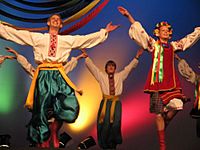
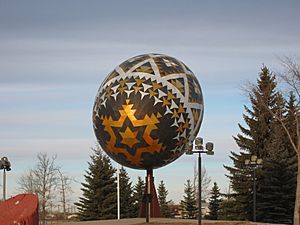
Canada has many lively Ukrainian dance groups. Some famous ones are the Ukrainian Shumka Dancers and the Cheremosh Ukrainian Dance Company in Edmonton. There are also hundreds of other groups.
The Ukrainian Canadian Foundation of Taras Shevchenko helps fund Ukrainian Canadian performing arts, writing, and visual arts.
Ukrainians are known for their beautifully decorated Easter Eggs, called pysanky. This tradition is also strong in Canada. The world's second largest pysanka is in Vegreville, Alberta.
Ukrainian Canadian churches are famous for their onion domes. Inside, these domes often have colorful murals. The churches also feature iconostasis, which are walls covered with icons.
Music and Sounds
Ukrainian Canadian musicians and groups include Randy Bachman, the Canadian Bandurist Capella, Ron Cahute, Rick Danko, Chantal Kreviazuk, and Theresa Sokyrka. The Edmonton-based group the Kubasonics mixes traditional Ukrainian music with modern styles.
Food and Flavors
Food is a very important part of Ukrainian culture. Special foods are made only for Easter and Christmas. For example, on Christmas Eve (January 6), a special twelve-dish meatless meal is served. The most famous Ukrainian foods are borshch (a beet soup), holobtsi (cabbage rolls), pyrohy or varenyky (dumplings often called "perogies"), and kovbasa (sausage).
Many Ukrainian foods and cultural items are celebrated with large roadside attractions in the Prairie provinces. For example, the world's largest perogy is in Glendon, Alberta. The world's biggest kovbasa is in Mundare, Alberta.
Important Institutions
There are many Ukrainian Canadian institutions, such as:
- the Ukrainian Canadian Congress – a national group that represents Ukrainian Canadians. It has branches across the country and many member organizations.
- the Ukrainian National Federation of Canada – founded in 1932 to unite Ukrainian Canadians. Its goals are to keep Ukrainian language and culture alive in Canada and support an independent Ukraine.
- the Ukrainian Canadian Civil Liberties Association – a group that protects the interests of the Ukrainian Canadian community.
- the Association of United Ukrainian Canadians – a cultural group.
- the Canadian Institute of Ukrainian Studies – located at the University of Alberta and the University of Toronto.
- St. Andrew's College – a seminary for the Ukrainian Orthodox Church of Canada in Winnipeg. It is also a student residence and cultural school.
- the Ukrainian Museum of Canada – based in Saskatoon, with branches in other major cities.
- the Ukrainian Cultural and Educational Centre (Oseredok) in Winnipeg.
- the Ukrainian Cultural Heritage Village – a living-history museum near Edmonton.
- the Ukrainian Canadian Foundation of Taras Shevchenko – provides money to support Ukrainian Canadian arts.
- the Centre for Ukrainian Canadian Studies at the University of Manitoba.
- the Ukrainian Cultural Centre of Toronto (UCCT).
- the Kule Folklore Centre at the University of Alberta.
- the Ukrainian Canadian Archives & Museum of Alberta in Edmonton.
- the Prairie Centre for the Study of Ukrainian Heritage at the University of Saskatchewan in Saskatoon.
- the Kobzar Literary Award – a prize for Canadian authors who write about Ukrainian Canadian themes.
- the St. Petro Mohyla Institute in Saskatoon – a student residence and cultural school.
- the Ukrainian Canadian Students' Union (SUSK/СУСК) – a national group for Ukrainian Canadian students.
- the Canadian Ukrainian Immigrant Aid Society – helps new immigrants settle in Canada.
- Ukrainian Canadian Social Services – helps new immigrants and Ukrainian Canadian seniors.
- the Taras Shevchenko Museum in Toronto.
- the Ivan Franko Museum inside the Ukrainian Labour Temple of Winnipeg.
Images for kids
-
Post-independence Ukrainian fifteen-kopiyka stamp commemorating the centennial of Ukrainian settlement in Canada, 1891–1991
-
Commemorative plaque and a statue entitled "Why?" / "Pourquoi?" / "Чому (Chomu)?", by John Boxtel at the location of the Castle Mountain Internment Camp, Banff National Park
-
A group of Ukrainian Canadians pictured at a celebration inside Toronto's Old Fort York, taken in May 1934. Photograph from the M.O. Hammond fonds held at the Archives of Ontario.
-
Ukrainian Museum of Canada, Saskatoon
-
Ukrainian Cultural and Educational Centre "Oseredok", Winnipeg
-
A Ukrainian folk music "orchestra" associated with the then Mykhailo Hrushevsky Institute of Edmonton, now known as St John's Institute
-
St Vladimir Institute, Toronto
-
Former Sheptytsky Institute building at Saint Paul University in Ottawa
See also
- List of Ukrainian Canadians
- List of Canadian place names of Ukrainian origin
- Canada–Ukraine relations
- European Canadians
- Toronto Ukrainian Genealogy Group


